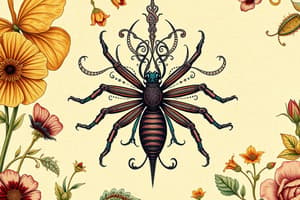Podcast
Questions and Answers
Which of these options are the three domains of life?
Which of these options are the three domains of life?
- Fungi
- Bacteria (correct)
- Archaea (correct)
- Eukarya (correct)
Which of these options are the six kingdoms of life?
Which of these options are the six kingdoms of life?
- Archaebacteria (correct)
- Protista (correct)
- Mammalia
- Eubacteria (correct)
Kingdom Archaebacteria is placed into which domain?
Kingdom Archaebacteria is placed into which domain?
Archaea
Kingdom Eubacteria is placed into which domain?
Kingdom Eubacteria is placed into which domain?
Domain Eukarya contains how many kingdoms?
Domain Eukarya contains how many kingdoms?
Members of Eubacteria have what type of cell?
Members of Eubacteria have what type of cell?
Members of domain Eukarya have what type of cell?
Members of domain Eukarya have what type of cell?
Amoeba, Paramecium and algae are in Kingdom __________ Domain: __________.
Amoeba, Paramecium and algae are in Kingdom __________ Domain: __________.
Dogs, Cats, Humans, and insects are in kingdom: __________ Domain: __________.
Dogs, Cats, Humans, and insects are in kingdom: __________ Domain: __________.
Mosses, ferns, trees, and flowers are in kingdom: __________ Domain: __________.
Mosses, ferns, trees, and flowers are in kingdom: __________ Domain: __________.
Bacteria placed into Domain: ___________ have cell walls with peptidoglycan.
Bacteria placed into Domain: ___________ have cell walls with peptidoglycan.
Bacteria placed into Kingdom: __________ have cell walls with peptidoglycan.
Bacteria placed into Kingdom: __________ have cell walls with peptidoglycan.
Bacteria placed into domain: ___________ and Kingdom: ___________ have cell walls that do not have peptidoglycan.
Bacteria placed into domain: ___________ and Kingdom: ___________ have cell walls that do not have peptidoglycan.
Members of kingdom Eubacteria are all which type?
Members of kingdom Eubacteria are all which type?
Members of Kingdom Protista can be classified as which of the following?
Members of Kingdom Protista can be classified as which of the following?
These kingdoms have all heterotrophic organisms:
These kingdoms have all heterotrophic organisms:
This kingdom has only autotrophic organisms.
This kingdom has only autotrophic organisms.
These kingdoms have some organisms that are autotrophic and some that are heterotrophic.
These kingdoms have some organisms that are autotrophic and some that are heterotrophic.
Kingdom Protista is placed into which domain?
Kingdom Protista is placed into which domain?
Kingdom Fungi is placed into which domain?
Kingdom Fungi is placed into which domain?
All members of this kingdom have cell walls made of chitin.
All members of this kingdom have cell walls made of chitin.
All members of this kingdom have cell walls made of cellulose.
All members of this kingdom have cell walls made of cellulose.
Some members of this kingdom have cell walls of cellulose and some have chloroplasts.
Some members of this kingdom have cell walls of cellulose and some have chloroplasts.
Mushrooms, yeasts, and puffballs are in kingdom: __________ Domain: __________.
Mushrooms, yeasts, and puffballs are in kingdom: __________ Domain: __________.
Flashcards are hidden until you start studying
Study Notes
Domains and Kingdoms Overview
- Three domains of life: Archaea, Bacteria, Eukarya.
- Six kingdoms of life: Eubacteria, Archaebacteria, Protista, Fungi, Plantae, Animalia.
Domain: Archaea
- Kingdom Archaebacteria belongs to the domain Archaea.
- Archaebacteria have cell walls that do not contain peptidoglycan.
Domain: Bacteria
- Kingdom Eubacteria is part of the domain Bacteria.
- Eubacteria possess cell walls containing peptidoglycan.
- Members are unicellular organisms.
Domain: Eukarya
- Contains four kingdoms: Protista, Fungi, Plantae, Animalia.
- Members include unicellular and multicellular organisms.
Kingdoms and Organisms
- Protista: Includes Amoeba, Paramecium, and various algae.
- Animalia: Houses animals like dogs, cats, humans, and insects.
- Plantae: Encompasses mosses, ferns, trees, and flowers.
Cell Types and Structures
- Eubacteria and Archaebacteria are primarily unicellular.
- Some Protista are unicellular; others may form colonies.
- Fungi are characterized by having cell walls of chitin.
- Plantae members have cell walls made of cellulose.
- Protista could have both cellulose cell walls and chloroplasts depending on the organism.
Nutritional Modes
- Fungi and Animalia consist entirely of heterotrophic organisms.
- Kingdom Plantae contains only autotrophic organisms.
- Kingdoms Eubacteria, Archaebacteria, and Protista have both autotrophic and heterotrophic members.
Studying That Suits You
Use AI to generate personalized quizzes and flashcards to suit your learning preferences.




